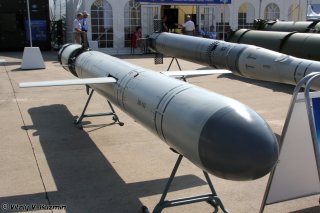Kalibr: The Russian Cruise Missile Built for War
The Russian Navy successfully conducted the latest test of its advanced Kalibr cruise missile last week.
The Russian Navy successfully conducted the latest test of its advanced Kalibr cruise missile last week.
The test launch was conducted from the Udaloy-class anti-submarine guided-missile destroyer/frigate Marshal Shaposhnikov, which recently completed a major upgrade that included 16 vertical launch systems for cruise missiles. The warship fired the missile from the Sea of Japan and hit a target on the Russian shores.
Russian Navy aircraft including helicopters of the maritime aviation unit maintained security in the region, which was closed to civilian traffic at sea and in the air.
"The Pacific Fleet's Marshal Shaposhnikov frigate in the Sea of Japan for the first time launched the Kalibr cruise missile on a surface target," a spokesperson for the Russian Ministry of Defense told Tass. "As scheduled the missile arrived at the firing range in the area of Cape Surkum where it struck a shore target. The distance of the firing on the target exceeded 1,000 km."
As noted by the official statement, the Russian Navy has classified the class of warships as Project 1155 and Project 11551 as frigates despite the fact that when the vessels were developed in the 1970s as the Udaloy-class, they were considered the Soviet equivalent of the American Spruance-class destroyers. It has originally been designated by the Soviet Navy as a large anti-submarine warfare (ASW) ship, but with its upgrades, it is now qualified as a frigate under Russian naval doctrine.
The warship had undergone its multi-year refit and upgrade at the Dalzavod Ship Repair Center in the city in Russian Far East. The upgraded 1155M Marshal Shaposhnikov has received the aforementioned Kalibr cruise missile launchers as well as two sets of 2M24 launchers, which contain four launch tubes each, for the Kh-35 Uran missile. The Kalibr-NK cruise missiles are land-attack cruise missiles that have a range of 1,500 to 2,500 kilometers.
The warship's anti-submarine and air defense capabilities were also enhanced. During the upgrade, the shipbuilders dismantled and reconstructed more than 20 percent of the frigate's superstructure, and the vessel's main cables were partially replaced. The shipbuilders also repaired the warship's sea valves and hull structures and installed new equipment. While undergoing its upgrade process, the ship was damaged by a fire, which delayed its return to service.
It began its sea trials in the Sea of Japan last summer after leaving the port of Vladivostok
The vessel, which is named for Boris Mikhaylovich Shaposhnikov, chief of the staff of the Red Army and Marshal of the Soviet Union during the Second World War, is scheduled to re-join the Pacific Fleet by the end of this year.
Following the upgrade of the Marshal Shaposhnikov, all seven of the additional Project 1155 warships are slated for a similar modernization.
Peter Suciu is a Michigan-based writer who has contributed to more than four dozen magazines, newspapers and websites. He regularly writes about military small arms, and is the author of several books on military headgear including A Gallery of Military Headdress, which is available on Amazon.com.

